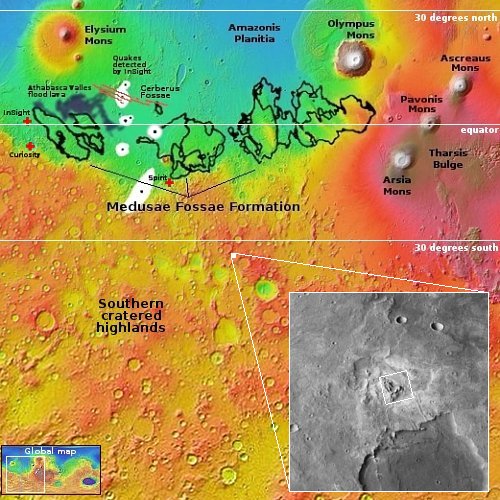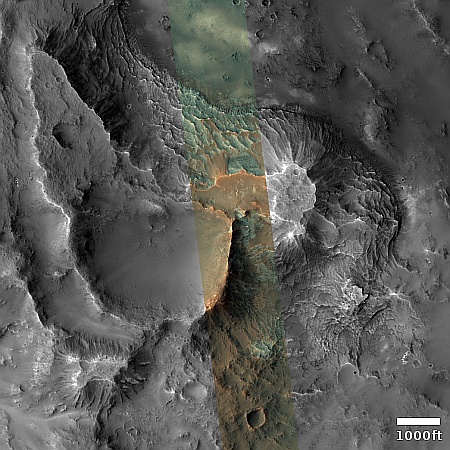A fluted mesa on Mars
Cool image time! The picture to the right, cropped, reduced, and sharpened to post here, was taken on July 9, 2024 by the high resolution camera on Mars Reconnaissance Orbiter (MRO). It shows what the science team labels a “silica-rich mound”, as indicated by the bright streaks on all the high ridge points.
The flat-topped mesa on the right drops about 200 feet to the valley floor. The rims of that depression to the west rise about 50+ feet higher, while mesa nose in the upper left rising another 50+ feet more.
Was the depression caused by an impact? If so, the landscape has changed radically since that impact occurred, with most of the surrounding terrain eroded away. The two flat-topped mesas hint at the ancient surface when that impact occurred.
A wider view however raises questions about this impact theory.

The white dot on the overview map to the right marks the location. As you can see in the inset, this silica-rich mesa complex is distinctly different than the plains and craters around it. That white material here dominates, suggesting that the mounds and depression might have formed by some chemical process that pushed material up from below ground, leaving behind a spray of surface silica.
Research relating to this region and nearby Columbus crater suggest that much of these deposits exist because of the past existence of deep lakes as well as groundwater springs. For this particular mound, the scientists propose three possible explanations for the silica deposits and the formation of this mesa:
(1) an erosional remnant mesa [my first guess], (2) a siliceous spring mound [my second guess], or (3) a volcanic construct that has been aqueously altered, possibly under acidic conditions.
Their analysis seems to favor the first or second choices, but with caveats for both, making it presently impossible with the available data to come to a firm conclusion.
On Christmas Eve 1968 three Americans became the first humans to visit another world. What they did to celebrate was unexpected and profound, and will be remembered throughout all human history. Genesis: the Story of Apollo 8, Robert Zimmerman's classic history of humanity's first journey to another world, tells that story, and it is now available as both an ebook and an audiobook, both with a foreword by Valerie Anders and a new introduction by Robert Zimmerman.
The print edition can be purchased at Amazon or from any other book seller. If you want an autographed copy the price is $60 for the hardback and $45 for the paperback, plus $8 shipping for each. Go here for purchasing details. The ebook is available everywhere for $5.99 (before discount) at amazon, or direct from my ebook publisher, ebookit. If you buy it from ebookit you don't support the big tech companies and the author gets a bigger cut much sooner.
The audiobook is also available at all these vendors, and is also free with a 30-day trial membership to Audible.
"Not simply about one mission, [Genesis] is also the history of America's quest for the moon... Zimmerman has done a masterful job of tying disparate events together into a solid account of one of America's greatest human triumphs."--San Antonio Express-News
Cool image time! The picture to the right, cropped, reduced, and sharpened to post here, was taken on July 9, 2024 by the high resolution camera on Mars Reconnaissance Orbiter (MRO). It shows what the science team labels a “silica-rich mound”, as indicated by the bright streaks on all the high ridge points.
The flat-topped mesa on the right drops about 200 feet to the valley floor. The rims of that depression to the west rise about 50+ feet higher, while mesa nose in the upper left rising another 50+ feet more.
Was the depression caused by an impact? If so, the landscape has changed radically since that impact occurred, with most of the surrounding terrain eroded away. The two flat-topped mesas hint at the ancient surface when that impact occurred.
A wider view however raises questions about this impact theory.

The white dot on the overview map to the right marks the location. As you can see in the inset, this silica-rich mesa complex is distinctly different than the plains and craters around it. That white material here dominates, suggesting that the mounds and depression might have formed by some chemical process that pushed material up from below ground, leaving behind a spray of surface silica.
Research relating to this region and nearby Columbus crater suggest that much of these deposits exist because of the past existence of deep lakes as well as groundwater springs. For this particular mound, the scientists propose three possible explanations for the silica deposits and the formation of this mesa:
(1) an erosional remnant mesa [my first guess], (2) a siliceous spring mound [my second guess], or (3) a volcanic construct that has been aqueously altered, possibly under acidic conditions.
Their analysis seems to favor the first or second choices, but with caveats for both, making it presently impossible with the available data to come to a firm conclusion.
On Christmas Eve 1968 three Americans became the first humans to visit another world. What they did to celebrate was unexpected and profound, and will be remembered throughout all human history. Genesis: the Story of Apollo 8, Robert Zimmerman's classic history of humanity's first journey to another world, tells that story, and it is now available as both an ebook and an audiobook, both with a foreword by Valerie Anders and a new introduction by Robert Zimmerman.
The print edition can be purchased at Amazon or from any other book seller. If you want an autographed copy the price is $60 for the hardback and $45 for the paperback, plus $8 shipping for each. Go here for purchasing details. The ebook is available everywhere for $5.99 (before discount) at amazon, or direct from my ebook publisher, ebookit. If you buy it from ebookit you don't support the big tech companies and the author gets a bigger cut much sooner.
The audiobook is also available at all these vendors, and is also free with a 30-day trial membership to Audible.
"Not simply about one mission, [Genesis] is also the history of America's quest for the moon... Zimmerman has done a masterful job of tying disparate events together into a solid account of one of America's greatest human triumphs."--San Antonio Express-News



What an interesting area for future explorers. Is there any temperature data over this place? I’m thinking geothermal hot springs in the past.